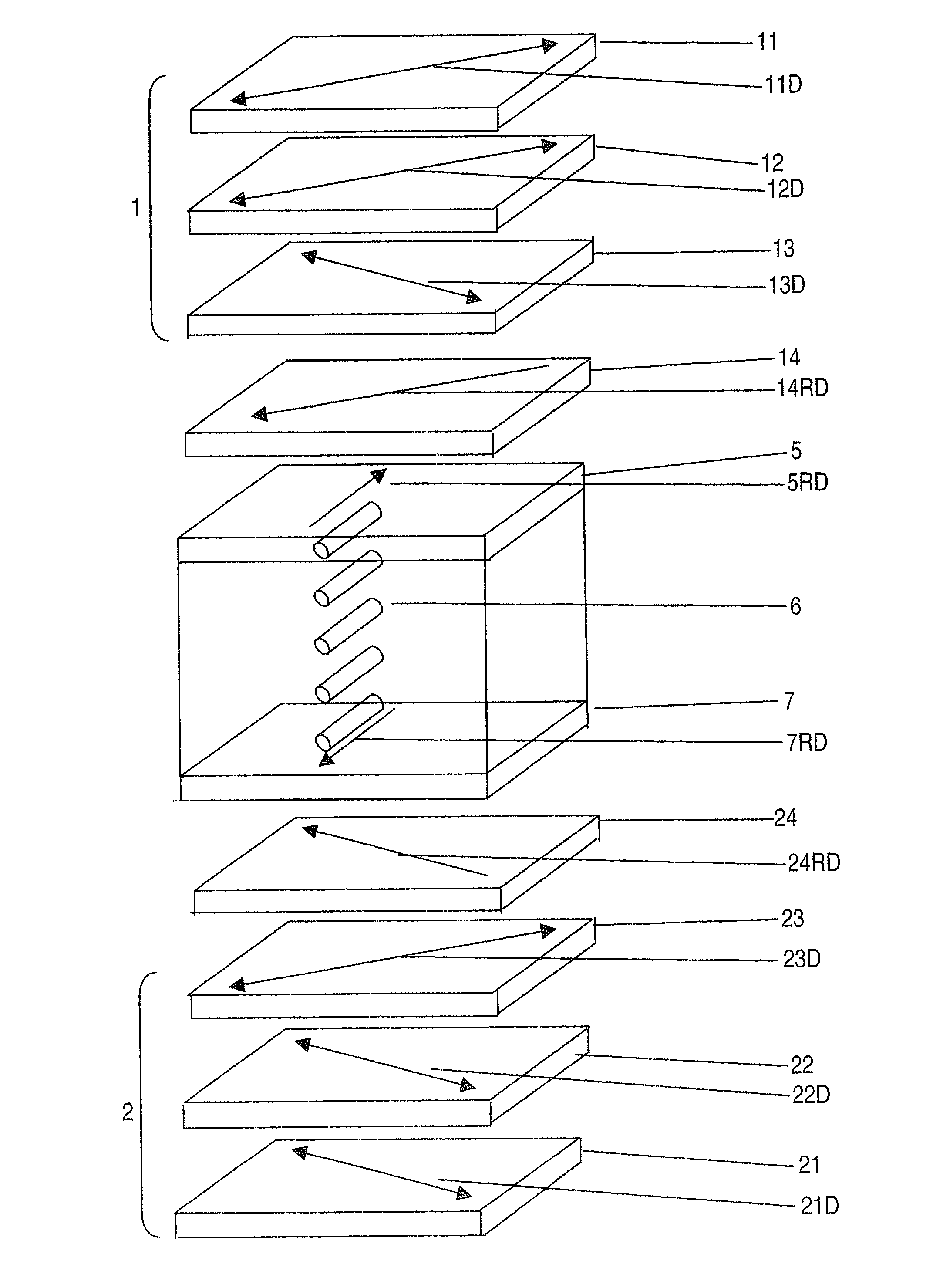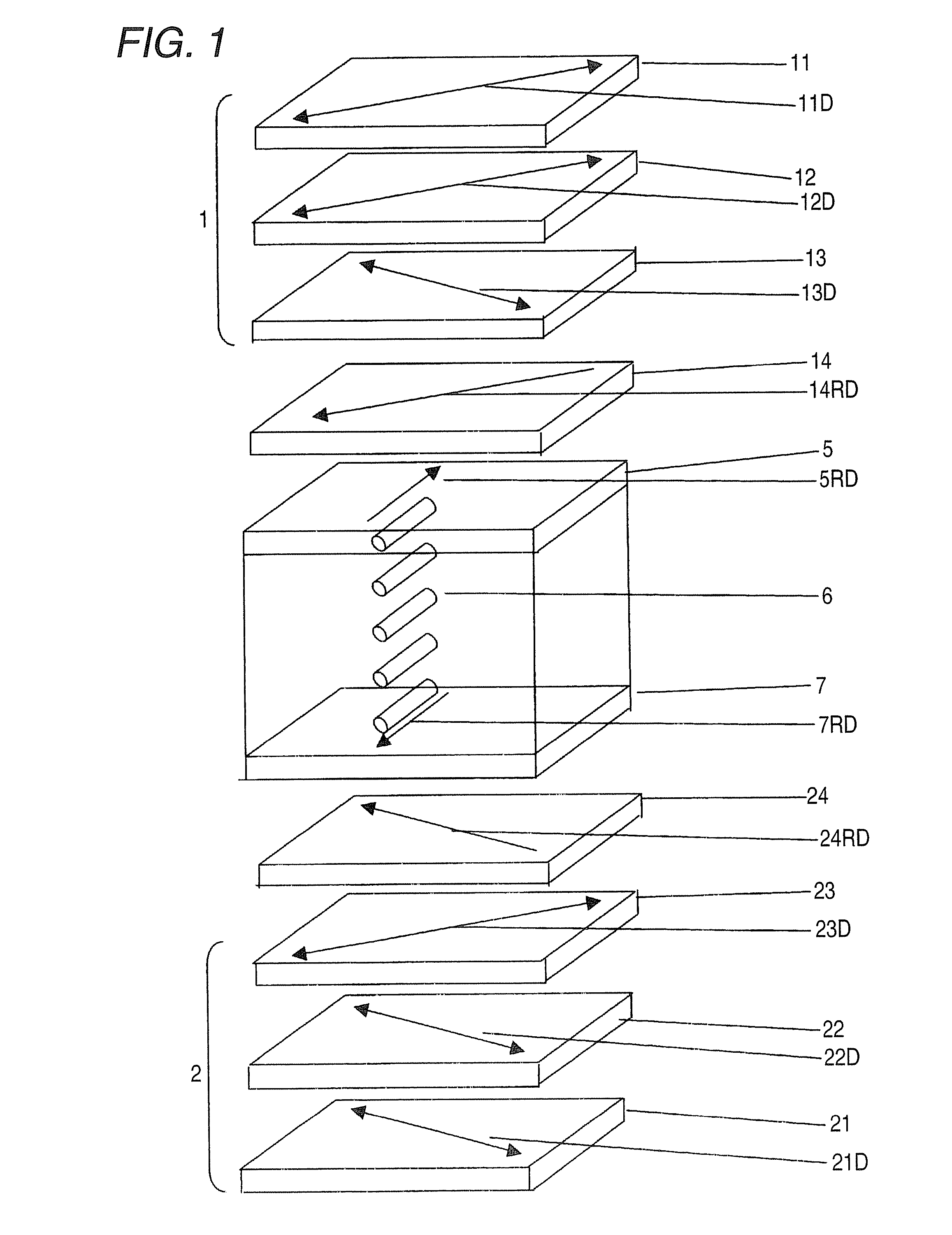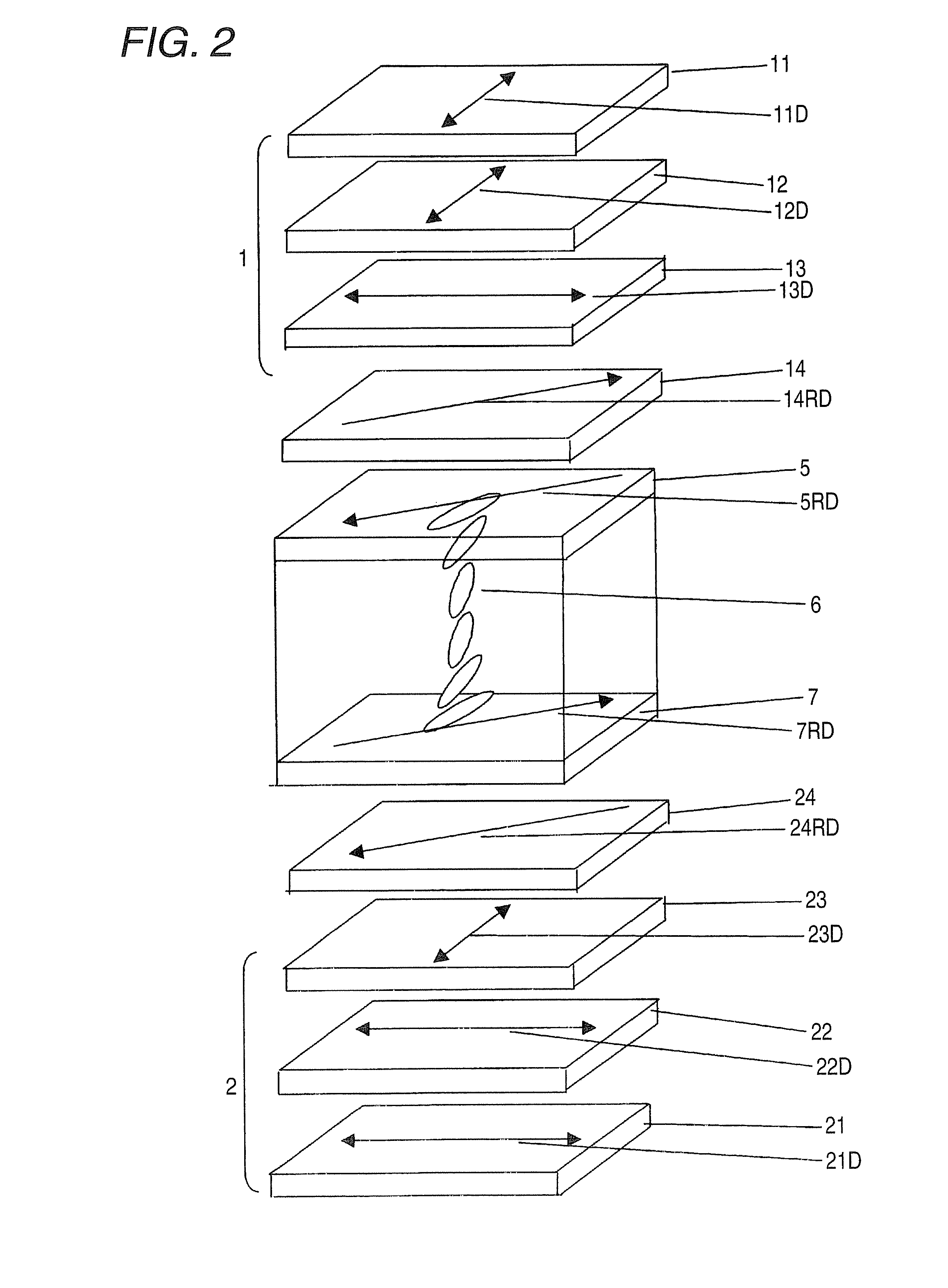[0414]FIG. 14 shows an example of a configuration of the
liquid crystal display of the invention. This example is merely used to explain the effect of the invention, and the invention is not limited to this example. Here, using nematic liquid crystals having positive
dielectric anisotropy as
field effect liquid crystals, a TFT (active) driving will be described by way of an example.
[0415]The TN mode liquid
crystal display shown in FIG. 14 comprises a
liquid crystal cell having an upper substrate 407, a lower substrate 410, and a liquid
crystal layer having liquid crystal molecules 409 interposed between these substrates. Alignment films (not shown) are formed on surfaces of the substrates 407 and 410 contacting the liquid crystal molecules 409 (hereinafter, these surfaces are sometimes referred to as “inner surfaces”), and alignment of the liquid crystal molecules 409 under application of no
voltage or application of a
low voltage is controlled by a
rubbing treatment to which the alignment films are subjected. In addition, transparent electrodes (not shown) that apply a
voltage to the liquid crystal layer having the liquid crystal molecules 409 are formed on the inner surfaces of the substrates 407 and 410. In addition, a pair of first upper and lower optically anisotropic
layers 405a and 412a and a pair of second upper and lower optically anisotropic
layers 405b and 412b are disposed with the
liquid crystal cell interposed therebetween. In the liquid
crystal display shown in FIG. 14, a liquid crystal panel Lp is constituted by the liquid
crystal cell, the pair of first upper and lower optically anisotropic layers 405a and 412a and the pair of second upper and lower optically anisotropic layers 405b and 412b. In addition, a pair of upper and lower polarizers 401 and 416 is disposed with the liquid crystal panel Lp interposed therebetween. Absorption axes 402 and 417 of the polarizers 401 and 416 have 90° (perpendicular) and 0° (parallel) with respect to a horizontal direction of a screen, thereby reducing light leakage out of circumferences of the polarizers, which occurs due to contraction of the polarizers under severe use environments.
[0416]The first upper and lower optically anisotropic layers 405a and 412a and the second upper and lower optically anisotropic layers 405b and 412b included in the liquid crystal panel Lp are formed of a composition containing a liquid crystal compound, and molecules of the liquid crystal compound in the layers are fixedly aligned in the alignment control directions defined by the alignment axis such as the
rubbing axis. An intersection angle between the alignment control directions 406a and 413a of the first optically anisotropic layers and at least one of the alignment control directions 408 and 411 of the liquid crystal layer falls within a range of 0° to 10° (preferably 0°) and an intersection angle between the alignment control directions 406b and 413b of the second optically anisotropic layers and one of the alignment control directions 408 and 411 of the liquid crystal layer is about 45°. It is preferable that an intersection angle between the alignment control directions of the optically anisotropic layers and the alignment control directions defined by a plane opposite the substrate disposed closer to the optically anisotropic layers falls with the above range (for example, an intersection angle between alignment control directions of the optically anisotropic layers 405a and 405b and alignment control directions of the liquid crystal layer defined by the alignment axis 408 such as the
rubbing axis formed on the plane opposite to the substrate 407 falls within the above range, and an intersection angle between alignment control directions of the optically anisotropic layers 412a and 412b and alignment control directions of the liquid crystal layer defined by the alignment axis 411 such as the rubbing axis formed on the plane opposite to the substrate 410 falls within the above range). An alignment control direction of an optically anisotropic layer refers to an average alignment direction of a molecule symmetrical axis of molecules in the optically anisotropic layer. In general, the alignment control direction is defined by a direction of rubbing treatment to which an alignment film used when the optically anisotropic layer is formed is subjected.
[0417]In addition, in the invention, it is preferable that the first optically anisotropic layer and the second optically anisotropic layer disposed as necessary are layers formed by fixing a liquid crystal composition containing a
discotic liquid crystal compound in a
hybrid alignment state.
[0418]It is here important that the liquid crystal panel Lp (interposed between the pair of second optically anisotropic layers in FIG. 14) has the double symmetrical axis in parallel to the surface of the substrate. One of the pair of polarizing plates with the liquid crystal panel Lp interposed therebetween is the upper polarizing plate including the
polarizer 401 and the transparent layer 403, and the other is the polarizing plate including the polarizer 416 and the transparent layer 414. The absorption axes 402 and 417 of the polarizing plates are in parallel or perpendicular to the double symmetrical axis of the liquid crystal panel. With this configuration, the
bilateral symmetry is obtained. In addition, in this aspect, by controlling the polarizing state of light incident from the outside of the upper and lower polarizing plates using optical characteristics of the transparent layers 403 and 414 according to the methods shown in FIGS. 19 to 22, a symmetry characteristic is also obtained in an inclined right upper 45° direction and an inclined left upper 45° direction. For example, polarization after polarized light incident from the outside in the inclined right upper 45° direction of the upper polarizing plate passes the transparent layer 403 and polarization of light incident in the upper front direction of the upper polarizing plate have the same elliptical polarizing state as in the long side direction of the polarization. Similarly, polarization after polarized light incident from the outside in the inclined left lower 45° direction of the lower polarizing plate passes the transparent layer 414 and polarization of light incident in the lower front direction of the lower polarizing plate have the same elliptical polarizing state as in the long side direction of the polarization. In this manner, the pair of polarizing plates is perpendicular to an elliptical polarizing axis in inclined upper and lower directions as well as the right and left directions, thereby obtaining symmetry in all of the inclined upper and lower directions and the right and left directions.
[0419]The TN mode liquid
crystal display shown in FIG. 14 has the same operation principle as the conventional liquid
crystal display shown in FIG. 15. Hereinafter, an example of a configuration of a TN mode liquid
crystal cell usable for the liquid crystal display shown in FIG. 14 will be described. A liquid
crystal cell is manufactured by rubbing and aligning liquid crystals having positive
dielectric anisotropy, anisotropic
refractive index Δn=0.0854 (589 nm, 20° C.), and Δε=+8.5, and is disposed between the upper and lower substrates 407 and 410. The alignment of the liquid crystal layer is controlled by the alignment film and the rubbing treatment. A director, a so-called tilt angle, indicating the alignment direction of the liquid crystal molecules is set to falls within a range of, preferably, about 0.1° to 10°. In this embodiment, the director is set to be 3°. The rubbing treatment is performed in a direction perpendicular to the upper and lower substrates, and the size of the tilt angle can be controlled by rubbing strength and number. The alignment films are formed by applying and firing a
polyimide film. The size of a twist angle of the liquid crystal layer is defined by an intersection angle in a rubbing direction between the upper and lower substrates and a chiral agent added to liquid crystal material. In this embodiment, a chiral agent having a
pitch of 60 μm or so is added so that the twist angle is about 90°. The thickness d of the liquid crystal layer is set to be 5 μm.
 Login to View More
Login to View More  Login to View More
Login to View More 


